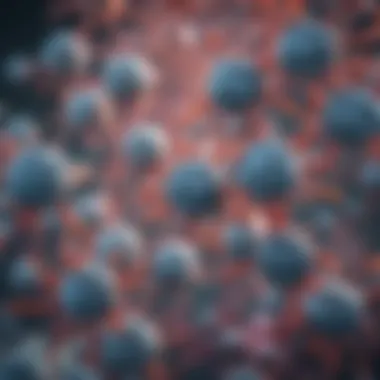In-Depth Analysis of Serine Protease 3 Antibodies


Intro
In the vast domain of molecular biology, few elements play as pivotal a role as antibodies. Among them, serine protease 3 antibodies have garnered increasing attention for their unique characteristics and critical functions. These antibodies are not just mere agents in the body's immune response; they offer profound insights into various biological processes, including the mechanisms of diseases and potential therapeutic strategies.
Understanding serine protease 3—and the antibodies that target it—provides a lens through which researchers can explore a myriad of biological phenomena. Such exploration uncovers not just their structure and function, but also their significance in health and disease, positioning them as valuable tools in both basic research and clinical applications.
Why This Matters
As research continues to evolve, the implications of these antibodies stretch far and wide, influencing fields such as oncology, immunology, and drug development. In this narrative, we aim to delve deeply into serine protease 3 antibodies, unpacking their structural nuances, biological roles, and potential applications. Through this exploration, we hope to illuminate the path for researchers seeking clarity amid the often-complex world of proteolytic enzymes and their antibodies.
By examining the connection between serine protease 3 antibodies and various disease mechanisms, we value the essence of them as not just research tools but as key players in understanding the intricacies of life at the molecular level.
Preamble to Serine Proteases
Understanding serine proteases is akin to peeling back the layers of a complex onion, revealing a multitude of vital functions these enzymes perform within living organisms. They are integral in protein degradation and processing, with a broad presence in various biological systems. In this article, the discussion centers around Serine Protease 3 and the related antibodies, positioning this exploration within the larger context of serine proteases. This foundational knowledge is indispensable, especially for students, researchers, educators, and professionals invested in biochemistry, molecular biology, and medical research.
Definition and Classification
Serine proteases are enzymes that play a crucial role in the hydrolysis of peptide bonds in proteins. Classified based on their active site serine residue, these proteases can be grouped into several families, primarily by their sequence homology and structural characteristics. Their classifications include:
- Chymotrypsin-like: Often found in digestive systems, these proteases preferentially cleave bonds adjacent to large hydrophobic amino acids.
- Trypsin-like: These prefer lysine or arginine residues and are important in blood coagulation.
- Elastase-like: They target regions near small side-chain amino acids such as glycine and alanine.
The classification points to their specific functions, suggesting that different serine proteases might have evolved for particular roles in various physiological contexts.
Historical Context
The journey of understanding serine proteases spans over a century. The discovery of proteases dates back to the late 19th century, but their specific role as serine-type enzymes was solidified through the 20th century. Initial works focused on trypsin, leading researchers to explore other related enzymes and their mechanisms. Notably, the mid-20th century saw an explosion of studies that characterized the catalytic mechanisms of these proteases, aided by advances in x-ray crystallography and molecular biology techniques.
Decades of research not only elucidated the structural framework that defines these enzymes but also revealed their significance in various pathophysiological processes. Thus, the crescent understanding of serine proteases has propelled extensive scientific exploration into their functionalities, therapeutic potentials, and relevance in disease processes. As we delve into Serine Protease 3, its historical backdrop enriches our comprehension of its biological significance and the journey leading to current therapeutic transformations.
The Role of Serine Protease
Understanding the role of Serine Protease 3 is paramount in grasping the broader implications this enzyme holds in both physiological and pathological conditions. This particular protease contributes to fundamental biological processes, influencing various mechanisms that underpin health and disease. By studying this protein, researchers can unravel its intricate functions, which can pave the way for clinical advancements and therapeutic interventions.
Biological Functions
Serine Protease 3, an enzyme with diverse roles, significantly influences homeostasis and enzymatic pathways. It acts primarily as a digestive enzyme, breaking down proteins into smaller peptides. Its prowess doesn’t stop there; it plays a critical part in the immune response as well, regulating inflammatory processes. Here are some key biological functions:
- Protein Catabolism: Its primary role involves the hydrolysis of peptide bonds, making it crucial for protein digestion and turnover.
- Regulation of Cell Signaling: This protease modulates signaling pathways, particularly those involving growth factors and receptors, impacting cell proliferation and differentiation.
- Immune Function: It is involved in processing immune mediators, facilitating the body’s response to pathogens and infections. This role underscores its importance in both adaptive and innate immunity.
However, it’s essential to emphasize that the improper functioning of Serine Protease 3 can lead to significant health consequences. For instance, abnormal activity has been linked to cancer progression through the dysregulation of apoptosis and cell cycle control.
Mechanisms of Action
Diving into the mechanisms of Serine Protease 3 reveals a sophisticated landscape of biochemical interactions. The protease operates through a catalytic triad—comprised typically of serine, histidine, and aspartate—that is crucial for its enzymatic activity. The specific steps in its action can be broken down as follows:
- Substrate Binding: Serine Protease 3 first binds to its specific substrates. This binding is often highly selective, showcasing the enzyme's specificity; it tends to recognize particular amino acid sequences or structures.
- Catalytic Activation: Once bound, the protease catalyzes the cleavage of peptide bonds. The serine residue in the active site plays a critical role, donating hydroxyl ions that facilitate the bond breakage.
- Release of Products: After catalysis, the products of hydrolysis are released, allowing the enzyme to reset for another cycle of activity. This efficiency underpins its pivotal functions in metabolic processes.
"The understanding of Serine Protease 3's mechanisms can lead to valuable insights in manipulating its activity for therapeutic gains."
In the grand scheme of biochemical reactions, Serine Protease 3 serves not just as a mere facilitator but as a pivotal switch in numerous biological pathways. Recognizing how it operates provides researchers and clinicians with actionable knowledge that could lead to breakthroughs in disease management. Understanding these roles and mechanisms strengthens the foundation for further studies into the clinical applications of Serine Protease 3 antibodies.
Structure of Serine Protease


Understanding the structure of serine protease 3 is fundamental in comprehending its role in biological systems. The spatial arrangement of its amino acids and the resulting three-dimensional conformation dictate not only how the enzyme interacts with its substrates but also how it can be targeted for therapeutic applications or studied within various research contexts. When examining structure, one comes face to face with the elegant complexity that governs functionality in biological systems.
Amino Acid Composition
Serine protease 3 is characterized by a unique composition of amino acids that form its active site and influence its overall stability and specificity. Generally, serine proteases are defined by the presence of a serine residue in their catalytic site, typically surrounded by other residues that aid in proper folding and function. This typical group might include aspartates or histidines, assisting in the catalytic mechanism through acid-base chemistry.
Some key aspects about the amino acid composition:
- Catalytic Triad: At the core of serine protease activity lies a catalytic triad formed by serine, histidine, and aspartate. This triad plays a crucial role in the enzyme's ability to hydrolyze peptide bonds.
- Conserved Residues: Many serine proteases share conserved residues that help maintain the integrity of the protein structure, often suggesting evolutionary relationships among different proteases.
- Variable Regions: While some residues remain conserved, others may vary significantly across species, potentially altering substrate specificity and regulatory mechanisms.
This amino acid framework not only determines how the enzyme performs its functions but also what kind of disease mechanisms can be addressed when looking at serine protease 3.
Three-Dimensional Structure
The three-dimensional structure of serine protease 3 typically elucidates how this enzyme interacts with inhibitors and substrates, making it essential for both research and clinical applications. Techniques such as X-ray crystallography and nuclear magnetic resonance (NMR) have paved the way for visualizing these intricate structures, which can be vital in drug design and therapeutic interventions.
- Overall Fold: Serine proteases generally adopt a common fold, often presenting a barrel-like structure with a catalytic site at the center. This specific spatial layout permits efficient interaction with substrate molecules.
- Active Site Configuration: The architecture around the active site is critical; it ensures that substrates are properly oriented for catalysis. Additionally, modulating the size or shape of the active site can lead to varying specificity for different substrate peptides.
- Dynamics and Flexibility: The flexibility of the enzyme structure influences activity. Binding of substrates or inhibitors can induce conformational changes, enhancing or inhibiting the enzyme’s activity.
"The structure-function relationship in serine protease 3 not only helps to unravel its biochemical pathways but also shapes potential avenues for targeted therapies."
Future studies focusing on the structural aspects of serine protease 3 will undoubtedly provide deeper insights into its role in health and disease. This dynamic interplay of amino acid composition and three-dimensional architecture may well hold the key to understanding its involvement in various pathological conditions.
Development of Serine Protease Antibodies
The exploration of serine protease 3 antibodies represents a significant milestone within the landscape of biomedical research. These antibodies are not merely tools; they are pivotal elements in our increasingly sophisticated understanding of serine proteases' roles in physiological and pathological processes. This section highlights the essential techniques used to generate these antibodies and delineates the different types available, emphasizing their relevance across various disciplines.
Antibody Generation Techniques
The generation of antibodies targeting serine protease 3 is a nuanced endeavor that involves a selection of techniques, each critical in ensuring the production of effective and specific antibodies.
- Hybridoma Technology: A classical method still widely used involves immunizing animals (commonly mice) with specific antigens derived from serine protease 3. The immune response from the host is then fused with myeloma cells to create hybridoma cells that produce monoclonal antibodies. This approach guarantees a consistent supply of antibodies that are highly specific to the target.
- Recombinant DNA Technology: In recent years, this method has gained traction. Scientists clone genes that code for the desired antibodies and introduce them into host cells such as bacteria or yeast. This not only facilitates mass production but also enables the customization of antibody characteristics.
- Phage Display: This approach involves the use of a library of bacteriophages that express antibody fragments on their surface. Phages that bind to serine protease 3 are selected and amplified. This method allows the rapid identification of high-affinity antibodies suited for therapeutic applications.
- Single B-cell Technologies: An emerging frontier, this technique isolates individual B cells that produce antibodies against serine protease 3. These cells can be analyzed to produce monoclonal antibodies tailored to specific research needs. This method offers greater specificity and minimizes the risk of cross-reactivity commonly seen in other approaches.
By employing these techniques, researchers can produce serine protease 3 antibodies with high precision, fostering innovation in their applications.
Types of Antibodies
Understanding the various types of antibodies is also essential for grasping their applications in research and clinical settings. The types can broadly be categorized as follows:
- Monoclonal Antibodies: These antibodies are derived from a single clone of B cells and recognize a specific epitope on serine protease 3. They have a consistent structure and function, making them ideal for diagnostic and therapeutic purposes. For example, many cancer therapies leverage monoclonal antibodies to target specific cancer cells that overexpress serine proteases.
- Polyclonal Antibodies: In contrast, these antibodies are sourced from the serum of immunized animals and can recognize multiple epitopes on serine protease 3. Their variability may provide a broader recognition capability, useful in preliminary exploratory studies.
- Recombinant Antibodies: Produced using recombinant technology, these antibodies can be engineered for specific properties, such as improved stability or altered binding characteristics. They represent a modern approach to antibody development, with potential applications in targeted therapy.
- Labelled Antibodies: Often, antibodies targeting serine protease 3 are conjugated with labels such as fluorescent dyes or enzymes. This labeling enhances visualization and quantification in various assays, such as ELISA or western blotting, increasing the sensitivity and specificity of the experiments.
A focused understanding of these antibody types empowers researchers to choose the best suited for their specific application, paving the way for breakthroughs in biomedicine.
In summary, the development of serine protease 3 antibodies underpins a plethora of potential applications across diagnostics and therapeutics. As we continue to refine these techniques and types, the possibilities for impactful discoveries in health and disease are boundless, encouraging interdisciplinary collaboration and innovation.
Applications of Serine Protease Antibodies
The applications of serine protease 3 antibodies are as diverse as they are significant. In the ongoing evolution of biomedical research, understanding how these antibodies function opens up a world of possibilities for diagnostics and therapeutics. Their specificity for serine protease 3 makes them key players in developing tools and treatments that can enhance patient care. Let's unearth the important elements of this topic and look at a couple of critical areas where serine protease 3 antibodies are making their mark.
Diagnostic Uses
Serine protease 3 antibodies are vital in the diagnostic field, especially in cancer and cardiovascular disease. Their role as biomarkers is profound. In clinical settings, the presence of these antibodies can help identify the levels of serine protease 3, which might be elevated during pathological conditions.
For example, in certain cancers, serine protease 3 expression is often altered, providing a telltale sign of disease progression. By utilizing serine protease 3 antibodies for immunoassays—such as ELISA or Western blotting—researchers can accurately assess these changes. This not only aids in detecting diseases early but also informs treatment decisions.


Moreover, pathologists are increasingly employing these antibodies to better understand tumor microenvironments. The interactions between serine protease 3 and other proteins can unveil the complex mechanisms driving malignancies. Diagnostic tests leveraging these antibodies can help establish prognostic indicators, thus painting a clearer picture for clinicians and researchers alike.
"Diagnosing disease often hinges on understanding molecular signals, and serine protease 3 antibodies are invaluable in that respect. As tools for early detection and monitoring disease, they offer hope for improved patient outcomes."
Therapeutic Applications
The therapeutic potential of serine protease 3 antibodies is gaining momentum in various research arenas. These antibodies are not only crucial for diagnosis but are also being explored as agents to combat specific diseases. One of the most promising applications lies in targeted therapies for cancer. By engineering monoclonal antibodies against serine protease 3, researchers aspire to hinder its activity, effectively disrupting the pathway that may lead to tumor growth and metastasis.
Furthermore, serine protease 3 antibodies are being examined in treating inflammatory disorders. Given the elevated levels of specific proteases in inflammation, targeting these proteins with tailored antibodies holds promise for reducing tissue damage and modulating immune responses. This application isn't straightforward, but the potential benefits are indeed notable, especially as more studies are conducted.
- Key therapeutic avenues:
- Cancer Treatment: Monoclonal antibodies act to inhibit cancer cell proliferation.
- Autoimmune Disorders: Modulating immune response to mitigate damage.
In summary, the applications of serine protease 3 antibodies in diagnostics and therapeutics cannot be overstated. Their integral role in understanding disease mechanisms, coupled with their potential for innovative treatments, offers targeted solutions that can enhance patient care and outcomes in various pathological states.
Serine Protease in Disease Mechanisms
The investigation of serine protease 3 and its relationships to various diseases adds a significant layer of complexity to our understanding of these enzymes. Serine protease 3, also known as prostasin, plays a crucial role in several biological processes that intricately tie into disease mechanisms. This section will delve into its impact on cancer progression, cardiovascular diseases, and inflammatory disorders, illuminating the importance of this protease in the context of disease.
Cancer Research
In the landscape of cancer research, serine protease 3 has emerged as a player worth scrutinizing. The link between proteolytic activity and cancer metastasis has long been a topic of intense investigation. When we assess serine protease 3, its expression levels can reflect the aggressiveness of certain cancers. For instance, studies suggest that higher levels of this enzyme are often found in various tumor types, including breast and prostate cancer. This correlation highlights serine protease 3's potential role as a biomarker for cancer diagnosis and prognosis.
Moreover, it seems that serine protease 3 not only acts as an indicator but may also influence cancer cell behavior. There’s a growing body of evidence indicating that it modulates cellular signaling pathways associated with invasion and metastasis, which are key elements of cancer progression. Understanding the mechanisms behind its activity could pave the way for novel therapeutic interventions targeting this protease, making it a focal point in future oncologic studies.
Cardiovascular Diseases
The adage "the heart knows no bounds" could very well apply to the functions of serine protease 3 in cardiovascular health. Research suggests that alterations in the activity of this protease may contribute to various cardiovascular conditions. For instance, in cases of myocardial infarction or heart failure, abnormalities in serine protease 3 expression and activity have been observed. These changes might affect the balance of proteolytic processes, ultimately impacting heart function.
Additionally, serine protease 3 has been linked to the regulation of hypertension and vascular remodeling. It appears to modulate the activity of other proteins within the cardiovascular system that can lead to endothelial dysfunction or arterial stiffness. Understanding these mechanisms places serine protease 3 in a significant position within cardiovascular pathogenic studies, pointing toward potential therapeutic targets.
Inflammatory Disorders
When discussing inflammatory disorders, serine protease 3 has garnered attention due to its regulatory capabilities in the inflammatory response. The body's response to injury or infection inherently involves a finely-tuned interplay of proteases. Here, serine protease 3 seems to play a role in balancing inflammation, as its activity can influence the production of pro-inflammatory cytokines.
In diseases such as rheumatoid arthritis or inflammatory bowel disease, alterations in serine protease 3-associated pathways may exacerbate tissue damage and prolong inflammation. The enzymatic activity of serine protease 3 could either mitigate or amplify the inflammatory response, depending on the context. Therefore, understanding its nuanced role can be pivotal in developing targeted therapies aimed at mitigating inflammation effectively.
The ability of serine protease 3 to influence various biological pathways emphasizes its significance in a range of diseases. This makes it a critical focus for ongoing and future research.
Challenges in Research of Serine Proteases
Researching serine proteases is not just a walk in the park. It comes with its own set of hurdles that can trip up even the most seasoned scientists. Understanding these challenges isn't just academic; it has real implications for how effective our antibody applications can be, especially concerning serine protease 3. This section will highlight the significance of addressing these challenges, focusing on antibody specificity and the reproducibility of results.
Antibody Specificity
One major concern in the field is the specificity of antibodies targeting serine proteases. Antibodies are intended to bind to specific antigens, in this case, serine protease 3. However, the presence of similar proteases or other proteins can lead to cross-reactivity. This might result in misleading data and conclusions.
- Cross-Reactivity: As serine proteases often share structural similarities, antibodies may not always differentiate well between them. For example, study A showed that an antibody raised against serine protease 3 had about 30% cross-reactivity with serine protease 4. Such findings are not just trivial; they can mislead diagnostic processes and therapeutic applications.
- Optimization Techniques: To tackle this, researchers might employ techniques like affinity maturation or the use of peptide libraries to enhance specificity. However, these methods demand time and resources, which can be a significant roadblock, especially in labs working with limited funding.
Addressing antibody specificity is absolutely essential not only for improving the quality of data collected but also for advancing therapeutic research.


Reproducibility of Results
Reproducibility is another cornerstone of scientific integrity but often proves elusive in serine protease research. Variability in results can stem from many factors, complicating the path toward solid conclusions.
- Experimental Conditions: Factors such as differences in reagent quality, environmental conditions, and even slight variations in protocol can lead to vastly different outcomes. In one study, results varied by more than 40% simply due to differences in the temperature of reactions.
- Documentation Lapses: Another pitfall is the inadequate documentation or sharing of methodologies among researchers. Many times, valuable insights gained from one study might not be replicable due to omissions in detail or simply because the key steps were not shared in a public forum. This can lead to skepticism surrounding claims made in published studies.
To combat the issues around reproducibility, it's crucial to establish standardized protocols and encourage open communication between researchers. Such measures can lead to more reliable data and facilitate collaborative efforts in the field.
"To truly advance the field of serine protease research, tackling the challenges of antibody specificity and reproducibility is not just desirable; it's imperative."
In summary, the challenges encompassing serine protease research, particularly with antibody specificity and the reproducibility of results, are far from trivial. They require ongoing attention and innovative solutions to ensure that investigations yield accurate and applicable results, ultimately benefiting the broader scientific and medical communities.
Future Directions in Serine Protease Research
As the scientific community continues to unravel the intricate behaviors of serine proteases, particularly serine protease 3 and its antibodies, the future of this field appears both promising and diverse. The understanding of these enzymes paves the way for new therapeutic strategies, better diagnostic tools, and innovative treatment methodologies. Researchers are keen on exploring new avenues that not only refine existing knowledge but also open up playing fields for entirely new discoveries. In this context, looking ahead at the possible future directions in serine protease research becomes critical.
Innovative Approaches
Exploring innovative approaches to study serine proteases is pivotal for enhancing our comprehension of their functions. Several strategies show great potential:
- Advanced Spectroscopy Techniques: Utilizing state-of-the-art methods such as nuclear magnetic resonance (NMR) and mass spectrometry can help in visualizing interactions in real-time, offering a clearer insight into protease mechanisms.
- Structural Biology Advances: With the rise of cryo-electron microscopy, researchers can achieve a more nuanced understanding of protease structures and how these relate to their biological actions. Resolving three-dimensional structures at atomic resolution is essential for drug design and development.
- Gene Editing Technologies: The implementation of CRISPR-Cas9 allows scientists to modify specific genes that encode proteases, offering a way to investigate these enzymes in vivo, thus providing insights into their physiological roles and potential therapeutic targets.
By adopting these innovative techniques, researchers might not only accelerate the pace of discovery but also enhance the applicability of serine protease research to real-world problems.
Collaborative Research Efforts
The collaborative nature of scientific research cannot be understated, especially in the field of serine proteases. Engaging with multidisciplinary teams can elevate the exploration of these complex proteins:
- Interdisciplinary Projects: Combining the expertise in fields such as biochemistry, molecular biology, and computational modeling can lead to unexpected insights. For example, not only studying the serine protease 3 through functional assays but also using bioinformatics tools to predict potential interactions and functions helps form a more complete picture.
- International Partnerships: Collaborating on an international scale can bring together top-tier researchers and provide access to a diverse array of tools and resources. It also fosters a rich exchange of ideas that can lead to innovative solutions and broader perspectives on research questions.
- Industry Collaborations: Partnering with pharmaceutical and biotechnology sectors can facilitate the translation of research findings into clinical applications. Such collaborations can help in the design of new therapies and diagnostic methods based on the role of serine proteases in various diseases.
To put it simply, fostering collaboration brings together unique insights and technological prowess, accelerating advancements in serine protease research.
The future of serine protease research depends on innovative methodologies and collaborative networks that transcend traditional boundaries.
In summary, the focus on innovative approaches and collaborative efforts is essential for pushing the boundaries of what’s currently known about serine protease 3 and its antibodies. This combination of forward-thinking and teamwork promises to deepen our understanding and enhance the potential therapeutic applications of serine proteases.
The End
In exploring the vast landscape of serine protease 3 antibodies, a few critical elements emerge that underscore the importance of our findings. The significant roles that these antibodies play in diagnostics and therapy cannot be overstated. They serve as vital tools in identifying and treating a range of diseases, from cancer to inflammatory disorders. As we have detailed, the interactions and specificity of these antibodies are crucial for their effectiveness, impacting both their application and understanding in various medical contexts.
"The nuanced understanding of serine protease 3 antibodies is foundational for both research and clinical practice."
Moreover, the implications of our study highlight the necessity for continued research into the mechanisms of action and structural characteristics of serine protease 3. This is paramount not only for advancing therapeutic applications but also for enhancing diagnostic accuracy. With the evolution of antibody generation techniques, we open the door to innovative opportunities, ultimately improving patient outcomes.
Summary of Findings
Throughout this article, we have delineated key findings regarding serine protease 3 antibodies:
- Biological Functions: These antibodies play crucial roles in various biological processes, aiding in the understanding of proteolytic mechanisms.
- Mechanisms of Action: Insights into how these antibodies interact with their targets deepen our comprehension of their therapeutic potential.
- Applications: Their diagnostic and therapeutic uses demonstrate their value in detecting diseases early and providing targeted therapies.
- Challenges: Issues such as antibody specificity and reproducibility of results are hurdles that researchers must confront moving forward.
The synthesis of this information presents a comprehensive view of the current landscape in serine protease research, reaffirming the importance of these antibodies in our scientific endeavors.
Implications for Future Studies
Looking ahead, several implications arise from our exploration:
- Innovative Research Techniques: The future may well lie in novel methodologies that enhance antibody effectiveness and specificity. For example, techniques such as CRISPR and monoclonal antibody development hold promise for deeper insights and improved therapeutic strategies.
- Collaborative Efforts: The complexity of diseases necessitates interdisciplinary studies engaging biologists, chemists, and medical professionals. Collaborations can stimulate a richer understanding of serine protease functions in health and disease.
- Comprehensive Databases: Establishing centralized databases that catalog research findings can aid researchers in tracking antibody characteristics, mechanisms, and applications, facilitating knowledge sharing and accelerating advances in the field.
In summary, this article sheds light on the profound importance of serine protease 3 antibodies while also pointing to the exciting paths for future inquiry. Recognizing and leveraging these implications will help ensure continued progress in biomedicine and therapeutic interventions.







